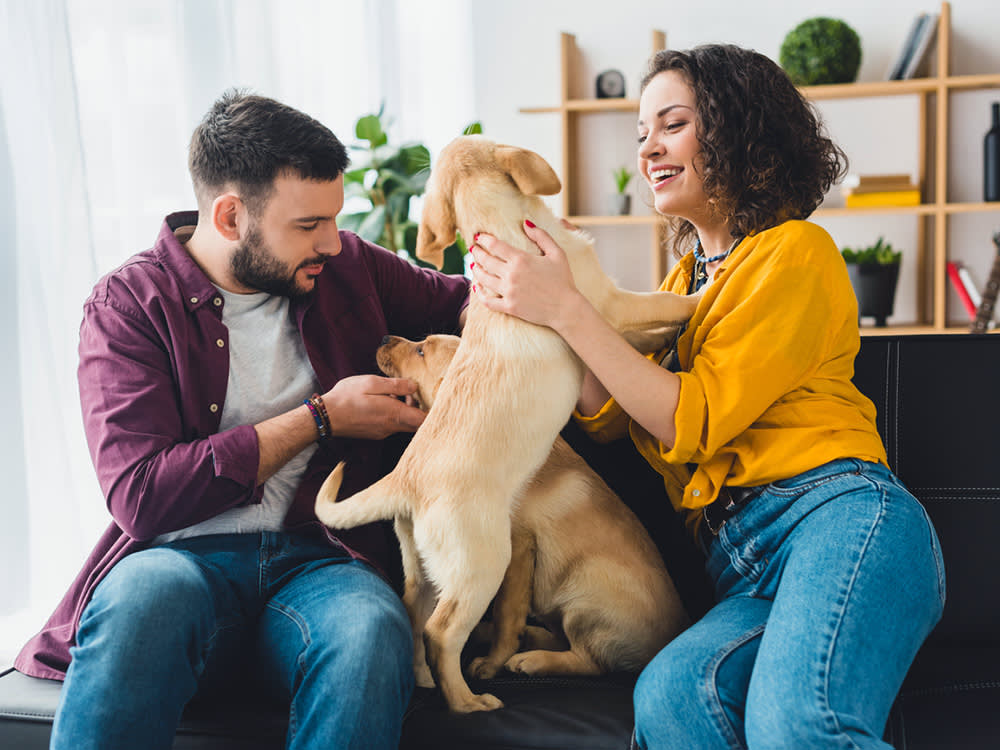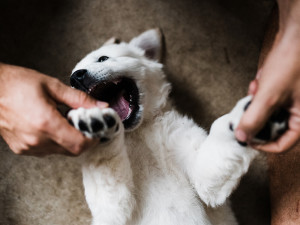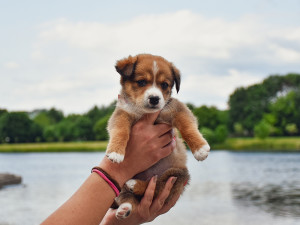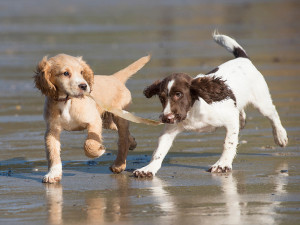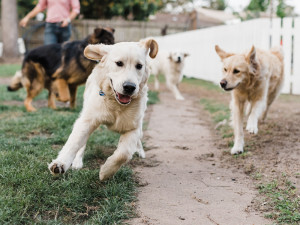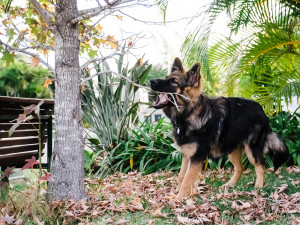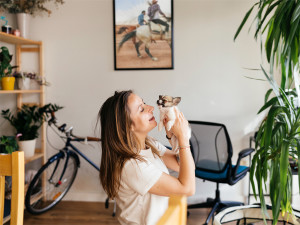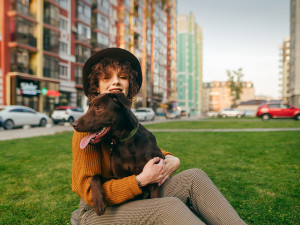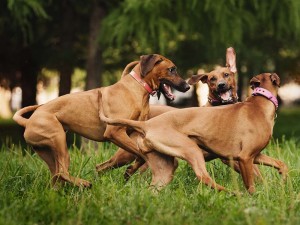There Is More Than One “Right” Way to Socialize Your Puppy
Take it slow. This process should never feel like speed-dating.
Your puppy is ready to meet the world, and you are ready to make the introductions. It’s go-time for socialization, which is the process of exposing a puppy to a variety of new experiences during the critical period of their lives from three to 14 weeks.
During this window of their development, puppies are open to new experiences, and these new experiences have a big impact on their behavior and emotions. If they have opportunities to experience a variety of sights, smells, sounds, materials, and other living beings when they are in this stage, not only will they have an easier time accepting anything and anyone they become acquainted with, they will find new situations, experiences, and social partners easier to accept and enjoy throughout their lives. It sounds simple, but getting the details right can make a big difference in how successfully their socialization prepares them for life.
It’s common to think of the two main parts of socialization as 1) meeting lots of new people of all kinds, and 2) meeting lots of new dogs of all types. But I maintain another way of dividing socialization into two categories: There’s the part of socialization that’s interactive and the part of socialization that’s observational.
Interactive puppy socialization
The interactive part of puppy socialization is the part of socialization that most people focus on. This is about meeting other individuals, especially people and dogs. The goal is to organize interactions for your dog with people and dogs in a way so that each experience is a positive one. That means carefully choosing the individuals your dog interacts with and controlling the type of interaction your puppy has with them.
How much do you spend on your pet per year?
The right kinds of social interactions
If your dog meets people who offer them treats, play with them in a way they enjoy, and handle them only in a gentle manner, your dog is likely to have positive feelings about people in general going forward. The same goes for dog introductions in that you make it likely that your dog will feel good about dogs in general if the ones they meet during their socialization period are gentle, polite, fun, and appropriately responsive to your dog.
Social interactions you should avoid
If, however, your puppy meets people who pick them up by surprise, talk too loud, charge at them with too much enthusiasm, or in any other way frighten or overwhelm them, that’s not proper socialization. Similarly, if your puppy meets dogs who plow into them, roll them over, threaten them, or are just too exuberant in general, your puppy will not develop positive associations about dogs. It’s essential that you avoid allowing your puppy to become scared or upset in the name of socialization because that will have the exact opposite effect of what you intend.
Your puppy needs good experiences with people and dogs, not just any old experience. Ideally the good experiences would be with people of different genders, sizes, races, ages, tones of voices and styles. They should meet people in wheelchairs and using canes, people wearing hats, people sporting beards, people who sing and dance, people delivering items to your home, and people who do handstands. They should meet dogs of all ages, sizes, breeds, and colors.
Why you need a plan for these meet-and-greets
It’s a good idea to have your dog interact with other species as well, especially if they will be sharing a home with them. Other common species besides people and dogs that dogs live with in their home are cats, ferrets, and pot-bellied pigs. They may also have contact with farm animals, such as sheep, goats, cows, and horses, in which case their socialization should include pleasant interactions with members of these species, too.
What’s key in interactive socialization is that the dogs learn that meeting new individuals is positive and that such individuals of various species are to be trusted. Meetings for interaction should be controlled and planned. They should be puppy-centric, meaning that they continue if the puppy is having a good time, but they cease immediately if the puppy is not. That requires pet parents to know how to read canine body language so they can assess their puppy’s emotional state.
These requirements cannot be met at the dog park or in huge crowds, so such places should be avoided. I am going to be very direct in order to be clear because it’s so important: just no, never, to socialization at the dog park.
Observational puppy socialization
Puppy socialization also includes exposure in a positive way to all kinds of sounds, sights, smells, and things to touch. A puppy will grow up to be able to handle the world better if they are gently exposed to sounds of the world, such as loud trucks, the kitchen mixer, the dishwasher, the garage door, and phone alerts in a positive way — paired with treats and your loving support.
Similarly, they benefit if they smell new soaps, vanilla, cleaning supplies, coffee, cedar, firewood, and the scent of anything else they will encounter in daily life. They should see animals who will not be their buddies such as birds, squirrels, and rabbits.
Introducing things that feel uncomfortable at first
Your puppy should also feel a variety of substrates and get used to walking on them. Because dogs walk directly on surfaces, it’s important they feel comfortable on them so they don’t avoid them later in life. Puppies should have the opportunity to have play sessions, receive treats, and be gently pet in pleasant ways when they are on carpet, grass, gravel, stone walkways, concrete, asphalt, tile and wood floors, bark chips, and other surfaces present in your area.
They should spend time in a crate, go by car to new places, and ride an elevator. They should see bicycles, dogs behind fences, skateboards, strollers, traffic lights, and puddles. Going to new places, smelling and hearing new things, and walking on new substrates should all be experiences that are positive ones for them.
It’s this type of socialization that is not as well-known, because it’s not about interacting socially with others in the environment but about observing the environment. They are experiencing aspects of the environment without interacting with it. (Walking on various surfaces could be considered interactive in the sense that the puppy has physical contract with the ground. I have put it in the observational category, because it is a sensory experience for the puppy rather than a social one. I am using interactive in the social sense.)
As always with socialization, it’s essential that experiences be positive and that you take breaks as needed, depending on your puppy’s emotional state. Brief exposures are easier to keep positive, so expose your puppy to something and associate the experience with good things, and then move on.
Misunderstandings about socialization
There has been a lot of confusion about socialization, and one reason is the persistent myth that socialization is about exposing your puppy to as many dogs, people, and experiences as possible. The idea that your puppy must meet 200 people as soon as they come home has done a lot of damage; good socialization is all about quality, not quantity. The goal is for your puppy to meet people and dogs and have good experiences, not to go through the meet-and-greet equivalent of speed dating.
Another reason for the confusion about socialization is that the word “socialization” connotes social interaction, but that is only part of socialization — the interactive part. It leaves out a huge part of the process — the observational aspect. So, the problem is a linguistic one. Ahh, isn’t English fun?
Comprehensive puppy socialization for your new best friend
Let’s review. When socializing a puppy, keep in mind these two components of the process: 1) Interactive: A dog who is comfortable in their world is able to interact with a variety of social partners including new acquaintances, and 2) Observational: A dog who is comfortable in their world is able to casually deal with or even ignore a variety of types of stimulation because they are used to a large number of sensory experiences.
A puppy who is properly socialized will have an easier, happier life, and we as their pet parents are more likely to enjoy them and their behavior. It’s easier to lead your puppy toward a lifetime of the behavior you want if you consider puppy socialization more broadly.
Ideal socialization involves exposure to the world with positive experiences as close to 100 percent of the time as possible. You want your puppy to learn about the world and know about what they will encounter throughout their life and how to handle anything new.
Knowing the proper way to socialize your puppy and being aware of the different aspects of the process as well as its goals will help you do right by your puppy.
References:
Puppy Socialization: What It Is and How to Do Itopens in new tab
